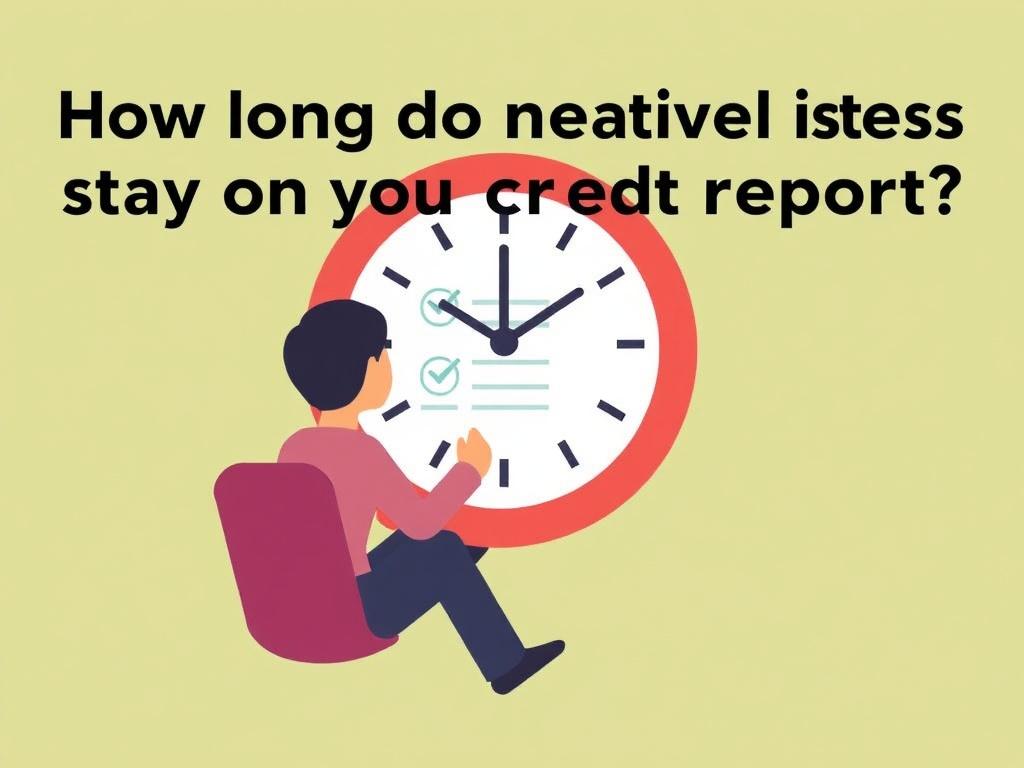SQLITE NOT INSTALLED
Содержание
What Are Negative Items on a Credit Report?

When you check your credit report, you might notice that not all information is positive. Negative items are entries that represent missed payments, defaults, or other financial missteps that could affect your credit score. These can include late payments, charge-offs, collections, bankruptcies, foreclosure, and more. Understanding how long negative items stay on your credit report is crucial because these entries can impact your ability to secure loans, rent apartments, or even get certain jobs.
Negative information tells lenders about your past credit behavior, making it a red flag if you’re trying to prove your creditworthiness. But it’s important to remember that these items don’t stay forever—they have specific time frames during which they remain on your report before falling off.
How Long Do Different Negative Items Stay on Your Credit Report?
Not all negative entries are created equal. Each type of negative item has its own lifespan on your credit report, regulated by the Fair Credit Reporting Act (FCRA) in the United States. Here’s a handy table to help you visualize the duration of common negative items on your credit report.
| Negative Item | Time on Credit Report | Notes |
|---|---|---|
| Late Payments | 7 years | Counted from the date of the missed payment |
| Charge-Offs | 7 years | Begins from the date account was charged off |
| Collections | 7 years | Starts from the date original account became delinquent |
| Foreclosures | 7 years | Counted from the foreclosure filing date |
| Medical Collections | 7 years | Same timeline as other collections |
| Bankruptcies (Chapter 7) | 10 years | Starts from the filing date |
| Bankruptcies (Chapter 13) | 7 years | Usually 7 years from filing date |
| Tax Liens (Paid) | 7 years | After payment, generally removed after 7 years |
| Tax Liens (Unpaid) | Indefinitely | Stay until satisfied or removed |
This table shows that most negative entries stay on your credit report for seven years, but bankruptcies can have a longer lifespan, generally up to 10 years. Understanding these timelines can help you plan your credit recovery process more effectively.
How Do Credit Bureaus Report Negative Items?

The three main credit bureaus—Equifax, Experian, and TransUnion—collect your credit data and create your credit report. These agencies all follow FCRA guidelines, but sometimes they report information slightly differently or on slightly different time frames due to reporting schedules. That means a negative item might fall off one report before it disappears from another.
When a negative item hits your credit file, it’s because a lender or collection agency reported it to one or more bureaus. Once reported, these negative pieces of information can influence your credit score. However, after the maximum time allowed by law, they should automatically drop off your report.
It’s important to check your reports regularly—at least once a year or more often if you’re actively working to improve your credit. You can dispute old negative information if it’s lingering past its allowable time. Credit bureaus must investigate and, if the information is outdated or inaccurate, remove it from your report.
How Does Reporting Date Affect Item Removal?
Credit bureaus determine negative items’ expiration dates based on the “date of first delinquency” (DOFD) rather than when the item was reported or when payment was made. The DOFD marks the first day you missed a payment for that debt, and this is the key date that starts the countdown.
For example, if you missed your first payment on a credit card in January 2017 but the account wasn’t charged off and reported as such until 2018, the DOFD would still be January 2017. The negative item should remain on your credit report until January 2024, 7 years later.
Keeping Track of Your Credit Report Timelines
Staying on top of negative items on your credit report means understanding when these entries expire. Different negative entries have different timelines, so tracking these dates helps you forecast when you can expect them to drop off. Here’s a simple step-by-step guide to keep organized:
- Obtain a copy of your credit report from all three major credit bureaus.
- Identify and list any negative items on each report.
- Note the date of first delinquency for each negative item.
- Calculate the expiration date by adding the allowable lifespan—usually seven or ten years—to the DOFD.
- Check your reports periodically to make sure old negative items have been removed after the expiration date.
By following this system, you can keep a clearer vision of your credit health and avoid surprises when financial institutions pull your credit during important loan or credit card applications.
How Negative Items Affect Your Credit Score Over Time
When negative items first show up on your credit report, they tend to hit your credit score hard. Missing payments, collections, or bankruptcies can cause significant drops in your credit score, sometimes by dozens or even hundreds of points, depending on how severe the damage is.
However, the impact of negative items lessens as they age. Even before they fall off your credit report, older negative entries weigh less on your credit score than recent ones. Credit scoring models such as FICO and VantageScore consider the “age” of derogatory items and reward those who have older negative events that show signs of recovery.
There are a few key points to understand about how negative items affect your score over time:
- Recent late payments are more damaging than those that occurred years ago.
- Repeated late payments on the same account amplify the damage.
- Paid collections are not as damaging as unpaid collections.
- Bankruptcies have a lasting impact but gradually diminish after several years.
Because negative entries lose their power over time, your credit score can start to improve even before the items disappear from your report. This is why it’s important to make positive financial decisions right after a negative item appears, such as making on-time payments and lowering your debt balances.
Can Negative Items Be Removed From a Credit Report Early?
Many consumers wonder if negative items can be removed before the legal expiration date. While the typical answer is no—they should remain for the full allotted time—there are a few exceptions:
- Errors and Inaccuracies: If a negative item is inaccurate or incomplete, you have the right to dispute it with the credit bureau. They must verify the claim and remove incorrect data.
- Goodwill Adjustments: In some cases, if you have a good payment history with a creditor except for one mistake, you can request a goodwill deletion. This is when a lender agrees to remove a negative item out of kindness.
- Pay for Delete Agreements: Sometimes, collection agencies may agree to remove a collection account in exchange for full payment. This is less common but worth exploring.
Here’s a quick summary table:
| Removal Method | Description | Likelihood |
|---|---|---|
| Dispute inaccurate information | Corrects errors or outdated info | High (if valid) |
| Goodwill adjustment | Creditor voluntarily removes item | Medium |
| Pay for delete | Collection agency removes item after payment | Low to Medium |
| Legal action | Challenging inaccurate collections or liens | Varies |
While early removal is tough, it’s worth trying if the item is wrong or if you have a strong case to convince your creditor.
What Can You Do to Improve Your Credit While Negative Items Remain?

Even though negative items can linger for years, you can still improve your credit report and score during their tenure. Here are some effective strategies that can help you rebuild your credit:
- Pay All Bills on Time: Timeliness is crucial. Setting up automatic payments or reminders helps prevent new late payments.
- Keep Credit Card Balances Low: Your credit utilization ratio, or how much credit you use compared to your credit limits, should ideally stay below 30%.
- Avoid Opening Too Many New Accounts: Multiple inquiries can lower your credit score. Be selective.
- Become an Authorized User: If possible, ask a trusted person with good credit to add you as an authorized user on their credit card. This can help boost your score.
- Build Positive Payment History: Consider secured credit cards or credit builder loans that report to credit bureaus.
- Check Your Credit Reports Regularly: Monitoring your reports helps catch errors or fraud quickly.
Improving your current financial behaviors sends positive signals to lenders and credit scoring models, allowing your credit profile to heal despite past negative items.
Final Thoughts on Negative Items and Credit Reports
Understanding how long negative items stay on your credit report is key to managing your credit health effectively. Most negative items, like late payments, collections, and charge-offs, stay on your report for seven years, while more serious events like bankruptcies can last up to a decade. The date of first delinquency is the major factor that determines when negative items expire.
While these items can feel like an anchor, their impact lessens over time, especially if you work on improving your credit habits. Trying to remove negative entries early is sometimes possible but often difficult unless there’s an error or goodwill basis. The best strategy is to focus on building positive credit history, paying bills on time, and managing your debts responsibly.
Remember, your credit report is a dynamic document that reflects your financial journey. Negative items tell part of that story, but they don’t define you forever. With patience and informed action, you can navigate through and beyond these challenges toward healthier credit and greater financial opportunities.
Conclusion
Navigating the world of credit reports and understanding how long negative items stay on them can be daunting, but knowledge is power. Now that you know most negative entries remain on your report for seven years, with some like bankruptcies lasting up to ten, you can better manage your expectations and plan your next steps. Keep in mind that time, combined with consistent positive credit behavior, will help diminish the damage these items cause. Always review your credit reports regularly, dispute inaccuracies, and take proactive steps to rebuild your credit. Remember, your credit journey is a marathon, not a sprint, and with patience and persistence, you can overcome past setbacks and regain financial confidence.
Опубликовано: 23 July 2025 Кредитрон – блог о кредитах, финансах и прочих реверансах
Кредитрон – блог о кредитах, финансах и прочих реверансах

